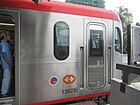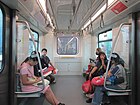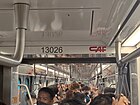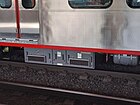| LRTA 13000 class | |
|---|---|
 A 13000 class train arriving at Central Terminal in October 2023 A 13000 class train arriving at Central Terminal in October 2023 | |
 Interior of the train captured in February 2024 Interior of the train captured in February 2024 | |
| Stock type | Light rail vehicle |
| In service | 2023–present |
| Manufacturer | CAF |
| Assembly |
|
| Family name | Urbos |
| Replaced | 1000 class |
| Constructed | 2019–2022 |
| Entered service | July 20, 2023; 17 months ago (2023-07-20) |
| Number built | 120 vehicles (30 sets) |
| Number in service | 92 vehicles (23 sets) |
| Formation | 4 cars per trainset (Mc–M–M–Mc) |
| Fleet numbers | 13001–13120 |
| Capacity | 1,388 passengers (264 seats; 4 wheelchair spaces) |
| Operators | Light Rail Manila Corporation |
| Depots | Baclaran, Zapote (future) |
| Lines served | |
| Specifications | |
| Car body construction | Stainless steel |
| Train length | 106 m (347 ft 9+15⁄64 in) |
| Car length | 26.5 m (86 ft 11+5⁄16 in) |
| Width | 2.59 m (8 ft 5+31⁄32 in) |
| Height | 3.91 m (12 ft 9+15⁄16 in) |
| Floor height | 0.92 m (3 ft 7⁄32 in) |
| Platform height | 0.69 m (2 ft 3+11⁄64 in) |
| Doors | 4 sets of 1.5 m (59 in) double-leaf pocket doors per side |
| Articulated sections | 2 |
| Wheel diameter | 660–600 mm (26–24 in) (new–worn) |
| Wheelbase | 1.9 m (6 ft 3 in) |
| Maximum speed | 60 km/h (37 mph) |
| Weight |
|
| Axle load | 10.5 t (23,000 lb) |
| Steep gradient | 4% |
| Traction system | Mitsubishi Electric IGBT–VVVF |
| Traction motors | 4 × 105 kW (141 hp) 3-phase AC induction motor |
| Power output |
|
| Transmission | Westinghouse-Natal (WN) drive 7.48 gear ratio; 2-stage reduction |
| Acceleration | 1 m/s (2.24 mph/s) |
| Deceleration | 1.3 m/s (2.91 mph/s) |
| Auxiliaries |
|
| HVAC | Roof-mounted duct-type air conditioning |
| Electric system(s) | 750 V DC overhead catenary |
| Current collector(s) | Schunk single-arm pantograph |
| UIC classification | Bo′+2′+Bo′ |
| Bogies | Inside-frame type |
| Minimum turning radius | 25 m (82 ft) |
| Braking system(s) | Regenerative, rheostatic, and electro-pneumatic |
| Safety system(s) | Alstom Atlas 100 ATP |
| Coupling system | Semi-permanent |
| Seating | Longitudinal |
| Track gauge | 1,435 mm (4 ft 8+1⁄2 in) standard gauge |
| Notes/references | |
| Sourced from unless otherwise noted. | |
The LRTA 13000 class is a class of fourth-generation high-floor light rail vehicles (LRV) of the Light Rail Transit Authority servicing the LRT Line 1.
Purchased in 2017 with Japanese funding as part of the Cavite extension of the line, the trains, manufactured by CAF, entered service in July 2023 to replace the aging first-generation 1000 class trains.
It is the first LRV in the system with 5 digits in the body number due to the class fleet exceeding 99 units, in comparison to the older fleet.
Operational history
Purchase
To prepare for the construction of the south extension of the LRT Line 1 to Cavite, new trains were needed to meet the growing demand. As such, on October 16, 2015, the Department of Transportation and Communications (DOTC) called for bids for the purchase of 120 light rail vehicles, configurable to thirty four-car trainsets, with Japanese companies only allowed to participate in the tender, In February, DOTC identified Marubeni and Sumitomo Corporation as prospective bidders. However, in April, the DOTC announced a failed bidding as none of them submitted proposals.
On December 28, 2016, DOTC's successor, the Department of Transportation (DOTr), called for bids again. Two bidders showed up: Marubeni with Hyundai Rotem, and Mitsubishi Corporation with Construcciones y Auxiliar de Ferrocarriles (CAF). The latter won the JPY 30 billion (PHP 14.1 billion) contract on November 19, 2017, and the contract was signed on December 1. These trains are expected to gradually replace the aging 1000 class which has been in use since the opening of the line in 1984 and has undergone three refurbishments.
Mitsubishi implemented the contract and supplied the trains while CAF manufactured the trains. The new trains were funded by Japan's official development assistance.
Production and commissioning

Officials of the Department of Transportation (DOTr) unveiled a full-scale mock-up model of the 13000 class train on May 7, 2019.
The first two sets (8 cars) were initially planned to be delivered in July 2020, however the delivery of the train sets were delayed due to the COVID-19 pandemic.
On January 18, 2021, the first batch of deliveries, consisting of the first trainset (4 cars consisting of two articulated cars each) arrived at the Port of Manila. These were unveiled to the public the following January 26. This trainset was then transported to Baclaran Depot in February.
The first trainset underwent static tests at the depot on September 15, 2021, followed by dynamic tests along the mainline on September 25. The trains then underwent 1,000-kilometer (620 mi) test runs conducted by the Light Rail Manila Corporation on May 4, 2022. Initially expected to enter in-service operations by the end of the month, the initial deadline was not met.

On July 19, 2023, the trains were inaugurated by President Bongbong Marcos. The first train set entered revenue service the next day. More trainsets from the 13000 class are expected to be incrementally entered into service, with one additional train set every week until every trainset enters service. All trains are expected to enter service by the fourth quarter of 2024, once the Cavite Phase 1 extension is opened. As of December 23, 2024, 23 trainsets have been deployed for revenue service.
Water leaks
A few months before the trains entered service, Transportation Undersecretary for Railways Cesar Chavez disclosed on February 16, 2023, that water leaks were found in eighty LRVs that were delivered to the Philippines. He further disclosed that as a result, these could not be used in mainline operations, and the government suspended payments to Mitsubishi and CAF in July 2022.
Chavez admitted that as a result of travel restrictions caused by the pandemic, the DOTr was unable to send inspection teams to inspect the trains for any defects, while these were still undergoing factory acceptance tests. These defects were later fixed through a comprehensive roof rectification plan.
Design

The LRV design is a 6-axle rigid body consisting of two articulated cars, like those of the 1100 and 1200 class trains. These are mainly operated in sets of four, and are capable of operating at a two- or three-car configuration under special circumstances.
Car body
The train car body is made of stainless steel. Each vehicle has four pocket doors per side. Initially, the trains were to sport a silver-yellow livery, but was changed to crimson and silver after the mock-up model was unveiled in 2019. The trains also feature LED destination panels, like the 1200 class.
-
 Driver's door at the front cab
Driver's door at the front cab
-
 13000 class exterior
13000 class exterior
-
 Roof-mounted resistor for regenerative braking
Roof-mounted resistor for regenerative braking
Front cab variations
The fourth-generation trains vary in two frame colors. The first two sets (Trainsets 1 & 2), built in Spain, have a red-painted "forehead" above the windshield and LED sign, while sets 3 to 30, built in Mexico, received a black "forehead".
Some train sets has varying signage data as well; train sets that arrived and/or were certified prior to the renaming of Roosevelt station to Fernando Poe Jr. station retained its destination signage. Later train sets feature the correct destination name which is noted to scroll instead of being static. All train sets had its signage data been updated in preparation for opening of the Cavite Extension Phase 1.
Interior
As opposed to the older rolling stock, the 13000 class includes hand straps aside from safety handrails installed above the train floor.
The trains are also the first in the Philippines to feature a specially-made wheelchair-compatible space or passenger with restricted mobility (PRM) areas, located closer to the driver's cab as compared to the 1100 class and 1200 class where it is located near the articulation. Unlike the 1200 class, there are also fewer side handrails in the middle sections of each vehicle. Longitudinal seating is present in the 13000 class, as per other train classes in the system.
Like the 1100 class and 1200 class, there are four pocket-type doors per side per car. For the driving cars, one door is installed on the side of the driving cab.
-
 Cab-end interior
Cab-end interior
-
 Non-cab end interior
Non-cab end interior
-
 Intercom
Intercom
-
 Hand straps
Hand straps
-
 Car number and manufacturer's sticker above an open gangway
Car number and manufacturer's sticker above an open gangway
Electrical and mechanical
Each LRV has three inside-frame bogies consisting of two motorized bogies at the ends and a Jacobs trailer bogie under the articulation. Semi-permanent couplers are installed at the ends of every light rail vehicle, except for the driving cab section of the head car.
These trains are easily recognizable by their distinctive braking sounds, which produce a screeching noise when stopping. This trait was not present in earlier train class sets, even when they were first introduced.
Like the 1100 class and 1200 class, each LRV consists of four 105-kilowatt (141 hp) 3-phase AC induction motors, driven by variable-voltage/variable-frequency drive (VVVF) inverters with insulated-gate bipolar transistors (IGBT). Auxiliary power is sourced from a static inverter, a low-power DC voltage supply, and batteries.
-
 Jacobs trailer bogie
Jacobs trailer bogie
-
 VVVF inverter
VVVF inverter
-
 Auxiliary Power Supply
Auxiliary Power Supply
-
 Schunk pantograph
Schunk pantograph
Signaling and control systems
The trains are equipped with the automatic train protection (ATP) system. Alstom was awarded the signaling and communications contract for the south extension of the LRT Line 1 in 2016. The contractual scope included the upgrading of the signaling system and the installation of the Atlas 100 on-board signaling solution for 60 train sets across the existing three generations of trains and the 13000 class trains.
The trains are also equipped with a Train Control and Monitoring System (TCMS).
Train formation
The configuration of a four-car trainset is Mc–M–M–Mc. Mc denotes a driving car while M denotes an intermediate car.
| Car type | Mc | M | |||
|---|---|---|---|---|---|
| A-car | B-car | A-car | B-car | ||
| Quantity | 2 | 2 | |||
| Control cab | |||||
| VVVF inverter | |||||
| Auxiliary inverter | |||||
| Pantograph | |||||
| Wheelchair spaces | |||||
| Car length | m | 26.5 | |||
| ft in | 86 ft 11+5⁄16 in | ||||
References
- CAF LRVs for DOTr (Department of Transportation), Republic of the Philippines (YouTube). Construcciones y Auxiliar de Ferrocarriles. March 24, 2021. Retrieved December 29, 2024.
- CAF 2023, p. 52.
- ^ "MANILA LINE 1 LRV". Construcciones y Auxiliar de Ferrocarriles. Archived from the original on September 7, 2023. Retrieved October 23, 2024.
- DOTC & LRTA 2015, p. 99-103.
- DOTC & LRTA 2015, p. 121.
- ^ DOTC & LRTA 2015, p. 126.
- ^ DOTC & LRTA 2015, p. 149.
- ^ DOTC & LRTA 2015, p. 152-153.
- ^ "Alstom to supply an integrated metro solution to Manila". Alstom. February 12, 2016. Retrieved February 19, 2022.
- Mariano, Keith Richard D. (October 16, 2015). "Only Japanese firms may bid for LRT-1 train supply deal – DOTC". GMA News. Retrieved December 30, 2021.
- Amojelar, Darwin G. (February 14, 2016). "Marubeni, Sumitomo bidding for 120 new cars of LRT 1". Manila Standard. Retrieved October 26, 2021.
- Amojelar, Darwin G. (April 3, 2016). "Bidding for new LRT 1 trains fails". Manila Standard. Retrieved June 13, 2024.
- Delavin, Imee Charlee C. (January 3, 2017) . "JICA-funded LRT-1 train supply deal opened to Japanese bidders". BusinessWorld. Retrieved June 9, 2024 – via Public-Private Partnership Center.
- Desiderio, Louella (September 3, 2017). "LRT 1 awaits notice to secure new trains". The Philippine Star. Retrieved October 26, 2021.
- "CAF and Mitsubishi win LRV contract in Manila". Railway PRO. November 21, 2017. Retrieved May 24, 2020.
- Construcciones y Auxiliar de Ferrocarriles (November 20, 2017). "CAF TO SUPPLY 30 LRVS TO MANILA (THE PHILIPPINES)". Construcciones y Auxiliar de Ferrocarriles. Retrieved May 22, 2020.
- "DOTr, Mitsubishi Corp. sign contract for procurement of Light Rail Vehicles for LRT-Line 1 Cavite Extension Project". PTV News. December 1, 2017. Retrieved October 26, 2021.
- Balinbin, Arjay L. "Train cars for LRT-1 Cavite extension starting to arrive". BusinessWorld. Retrieved January 27, 2021.
- Rocamora, Joyce Ann L. (November 20, 2017). "30 add'l LRT-1 train sets seen to decongest Manila traffic". Philippine News Agency. Retrieved December 30, 2021.
- "8 NEW STATIONS | LRT-1 extension construction officially kicks off today". News5. May 7, 2019. Retrieved June 10, 2024.
- Amojelar, Darwin (May 8, 2019). "LRT–1 expects new trains from Japan". Manila Standard (Press release). Retrieved May 23, 2020.
- ^ LRTA 2021, p. 22.
- Mercurio, Richmond. "Trains for LRT-1 Cavite extension arrived". Philstar.com. Retrieved January 27, 2021.
- Manabat, Jacque (January 26, 2021). "First batch of new train cars unveiled for LRT-1 extension". ABS-CBN News. Retrieved January 27, 2021.
- ^ LRTA 2021, p. 23.
- Cordero, Ted (May 4, 2022). "LRT1 operator begins testing 4th generation trains". GMA News. Retrieved May 4, 2022.
- Recuenco, Aaron (July 19, 2023). "New, state-of-the-art train sets await LRT-1 riders starting July 20". Manila Bulletin. Retrieved July 19, 2023.
- Good news, mga ka-riles 📣 More 4th Generation trains are now ready to serve #LRT1 passengers in time for the holiday season! 23 (out of 30) are already running along the main line for commercial service. Nakasakay ka na ba sa Gen-4 trains? Let us know! I-flex na ang iyong selfie sa Gen-4 trains below.💪🏼Ingat po sa biyahe! 🚊💙. Light Rail Manila Corporation. December 23, 2024 – via Facebook Reels.
- ^ Arcangel, Xianne (February 17, 2023). "Nearly all train cars delivered for LRT-1 Cavite Extension defective, says DOTr official". CNN Philippines. Archived from the original on February 18, 2023. Retrieved February 17, 2023.
- Mga depektibong bagon ng LRT-1, isasailalim sa roof rectification process – DOTr [Defective train cars of LRT-1 to undergo roof rectification process – DOTr] (in Filipino).
- ^ DOTC & LRTA 2015, p. 99.
- "Mitsubishi Corporation Awarded Contract to Supply Rolling Stock for Manila LRT Line-1 in the Philippines". Mitsubishi Corporation (Press release). November 20, 2017. Retrieved June 14, 2024.
- Surla, Sam (May 5, 2022). "LRT-1 will start running its 4th-generation trains". VISOR. Retrieved May 6, 2022.
- officialLRT1 (January 26, 2021). "LRMC welcomes new LRT-1 Generation-4 trains". Light Rail Manila Corporation. Retrieved May 25, 2021.
{{cite web}}: CS1 maint: numeric names: authors list (link) - DOTC & LRTA 2015, p. TS-66.
Sources
- Department of Transportation and Communications; Light Rail Transit Authority (October 16, 2015). "BIDDING DOCUMENTS - Part 2 for Procurement of New Rolling Stock LRV (4th Generation)" (PDF). LRT 1-South (Cavite) Extension Project. Archived (PDF) from the original on December 16, 2021. Retrieved December 16, 2021.
- "Gearboxes" (PDF). CAF MiiRA. December 2023. Retrieved June 11, 2024.
- Light Rail Transit Authority (March 2022). Year-End Accomplishment Report (CY 2021) (PDF) (Report). Retrieved March 12, 2022.
External links
![]() Media related to LRTA Class 13000 at Wikimedia Commons
Media related to LRTA Class 13000 at Wikimedia Commons
| Rolling stock of the Philippines | |||||||||||||||
|---|---|---|---|---|---|---|---|---|---|---|---|---|---|---|---|
| |||||||||||||||
| |||||||||||||||
| |||||||||||||||
| |||||||||||||||

